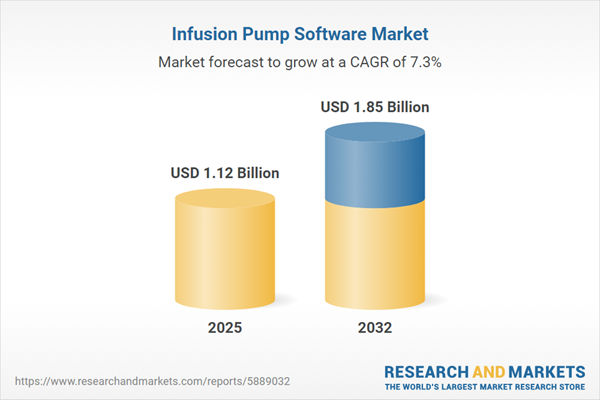Speak directly to the analyst to clarify any post sales queries you may have.
Infusion pump software continues to reshape how healthcare leaders approach digital transformation, driving improvements in medication safety, compliance, and operational performance across care environments. For senior decision-makers aiming to align technology with organizational goals, understanding the evolving landscape is essential for effective investment and risk management.
Market Snapshot: Infusion Pump Software Market Trends and Growth Outlook
The global infusion pump software market was valued at USD 1.05 billion in 2024 and is forecast to reach USD 1.12 billion by 2025, extending to USD 1.85 billion by 2032 with a CAGR of 7.33%.
This demonstrated growth highlights accelerating demand for accurate, automated delivery systems and an industry-wide push for deeper integration with hospital IT infrastructures. Technology suppliers are increasingly focused on interoperability and swift adaptation to shifting regulatory frameworks. Healthcare providers in acute, ambulatory, and distributed settings seek unified digital strategies that promote standardized compliance and greater transparency throughout medication processes.Scope & Segmentation: Key Segments in the Infusion Pump Software Market
- End Users: Hospitals, ambulatory centers, home care providers, and clinic networks rely on platforms that streamline medication delivery, enable real-time monitoring, and support efficient team collaboration. Scalability from enterprise-wide deployments to focused clinical contexts enables organizations to achieve diverse operational objectives.
- Delivery Methods: Smart pump software offering clinical decision support and workflow automation is evaluated alongside stable traditional options, ensuring flexibility and ease of integration across varied care environments.
- Deployment Modes: Cloud-based and on-premise solutions help organizations achieve alignment with their IT and security requirements, facilitating secure data management and accommodating evolving operational needs.
- Applications: Notable features such as automated dose error reduction, digital drug libraries, inventory monitoring, and analytics modules are central to enhancing safety and transparency within clinical workflows.
- Integration: Compatibility with leading electronic medical record and hospital information systems—including Allscripts, Cerner, and Epic—enables seamless workflow management and supports compliance initiatives.
- Regional Scope: Distinct adoption trends, regulatory environments, and purchasing considerations shape demand across regions like North America, Latin America, Europe, Middle East and Africa, and Asia-Pacific, emphasizing the importance of regionally tailored vendor support.
- Key Vendors: Major global providers like Baxter International, Becton Dickinson and Company, B. Braun Melsungen, ICU Medical, Smiths Medical, Fresenius Kabi, Terumo, Mindray Medical, Moog, and Getinge address complex and regional clinical needs with targeted solutions.
Key Takeaways for Senior Decision-Makers
- Adoption of artificial intelligence and advanced analytics within infusion pump software enables clinical teams to access real-time insights, improving decision-making and efficiency throughout care delivery channels.
- Cloud-based deployment models support standardization of technology management and clinical protocols, reducing reliance on broad in-house IT resources and facilitating scalable implementation.
- Robust cybersecurity measures, including advanced encryption and strict authentication, are becoming indispensable as networked devices become part of interconnected healthcare environments requiring regulatory compliance.
- User-focused design and portable software options ensure deployment flexibility, supporting continuous clinical workflows in hospitals, ambulatory settings, and home healthcare.
- Transparent licensing and modern partnership arrangements with vendors provide stronger cost control, smoother digital transformation, and the ability to quickly implement next-generation capabilities.
Tariff Impact: Navigating US Trade Policy Changes
Recent shifts in US trade policy—with tariffs impacting electronics and key sensor components—bring added cost complexities to the infusion pump software market. Healthcare organizations are addressing these by broadening supply chain sources, enhancing domestic manufacturing, and maintaining robust regulatory practices to ensure quality and resilience under fluctuating conditions.
Methodology & Data Sources
Research is grounded in direct interviews with healthcare executives and IT professionals, supplemented by thorough regulatory analysis and peer-reviewed academic research. These sources enhance the objectivity and strategic value of insights presented.
Why This Report Matters
- Helps executive teams align digital health investments and operational plans with emerging delivery models, compliance needs, and technology trends for optimal performance.
- Delivers guidance to manage regulatory, operational, and IT supply chain risks linked to evolving healthcare technology requirements.
- Enables informed strategic decisions about growth, partnership development, and long-term digital transformation initiatives in a competitive infusion pump software environment.
Conclusion
Senior leaders who leverage up-to-date market intelligence are well-positioned to guide effective technology adoption, anticipate regulatory shifts, and drive operational excellence in diverse healthcare settings.
Additional Product Information:
- Purchase of this report includes 1 year online access with quarterly updates.
- This report can be updated on request. Please contact our Customer Experience team using the Ask a Question widget on our website.
Table of Contents
3. Executive Summary
4. Market Overview
7. Cumulative Impact of Artificial Intelligence 2025
Companies Mentioned
The companies profiled in this Infusion Pump Software market report include:- Baxter International Inc.
- Becton, Dickinson and Company
- B. Braun Melsungen AG
- ICU Medical, Inc.
- Smiths Medical, Inc.
- Fresenius Kabi AG
- Terumo Corporation
- Mindray Medical International Limited
- Moog Inc.
- Getinge AB
Table Information
| Report Attribute | Details |
|---|---|
| No. of Pages | 183 |
| Published | November 2025 |
| Forecast Period | 2025 - 2032 |
| Estimated Market Value ( USD | $ 1.12 Billion |
| Forecasted Market Value ( USD | $ 1.85 Billion |
| Compound Annual Growth Rate | 7.3% |
| Regions Covered | Global |
| No. of Companies Mentioned | 11 |









